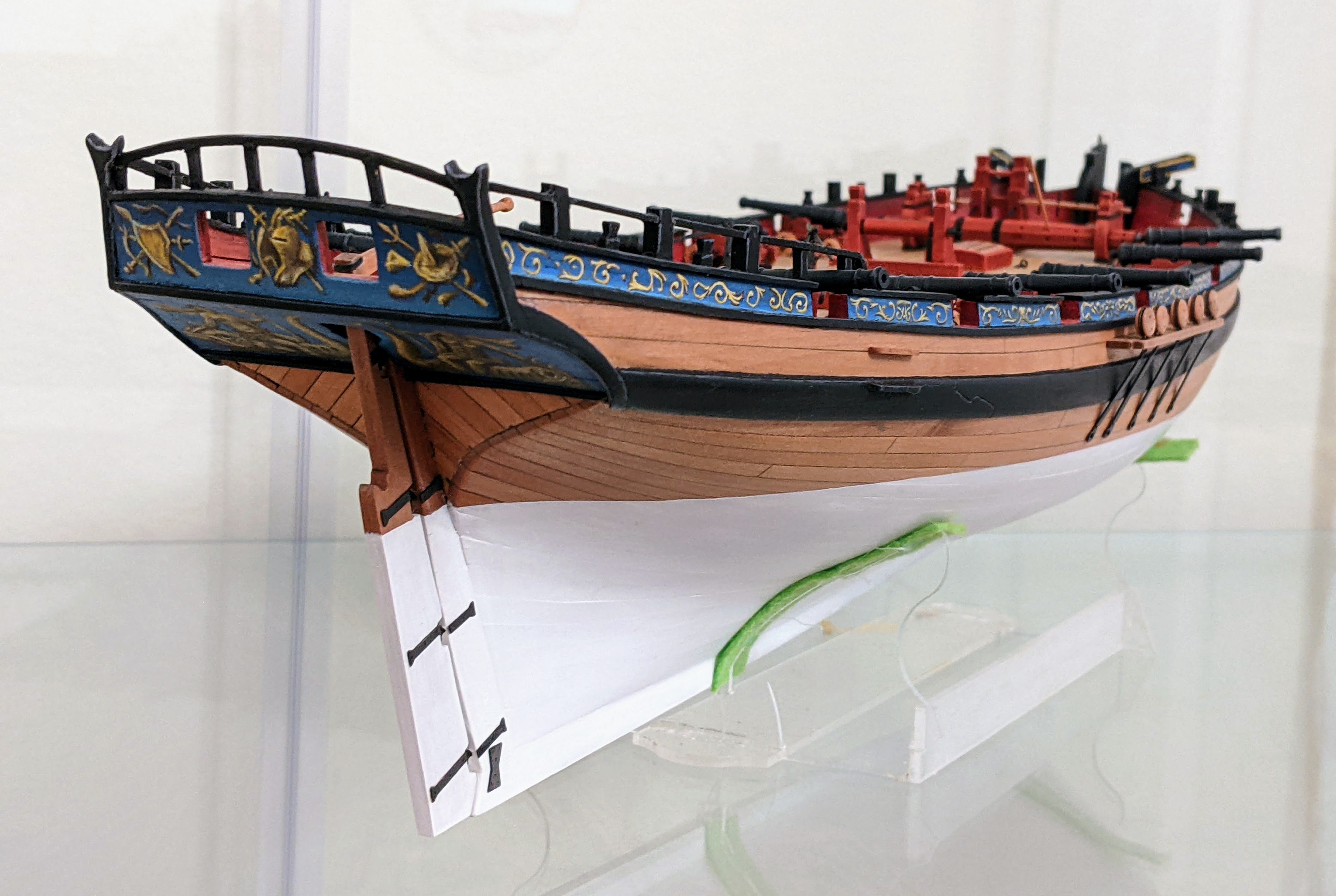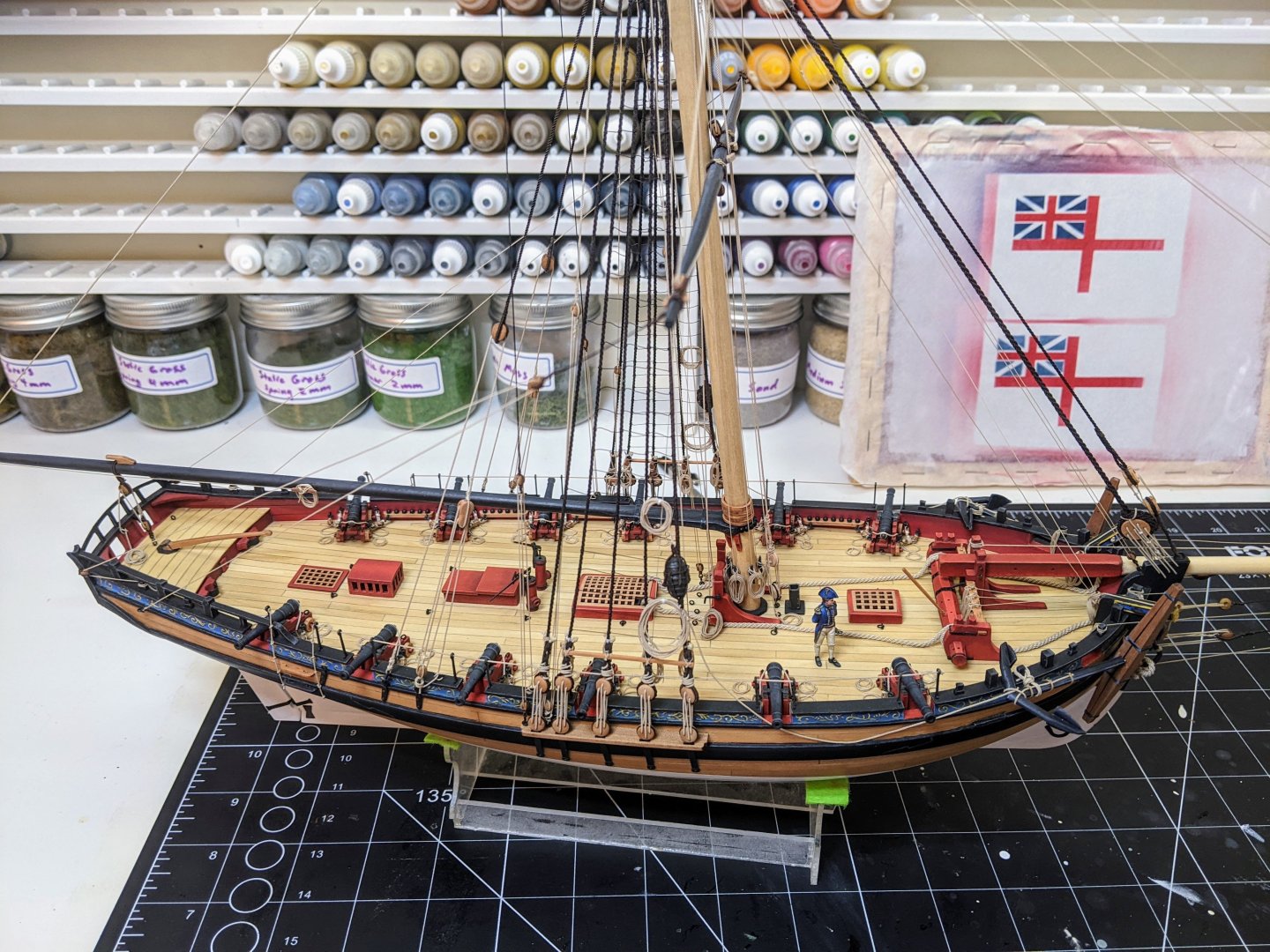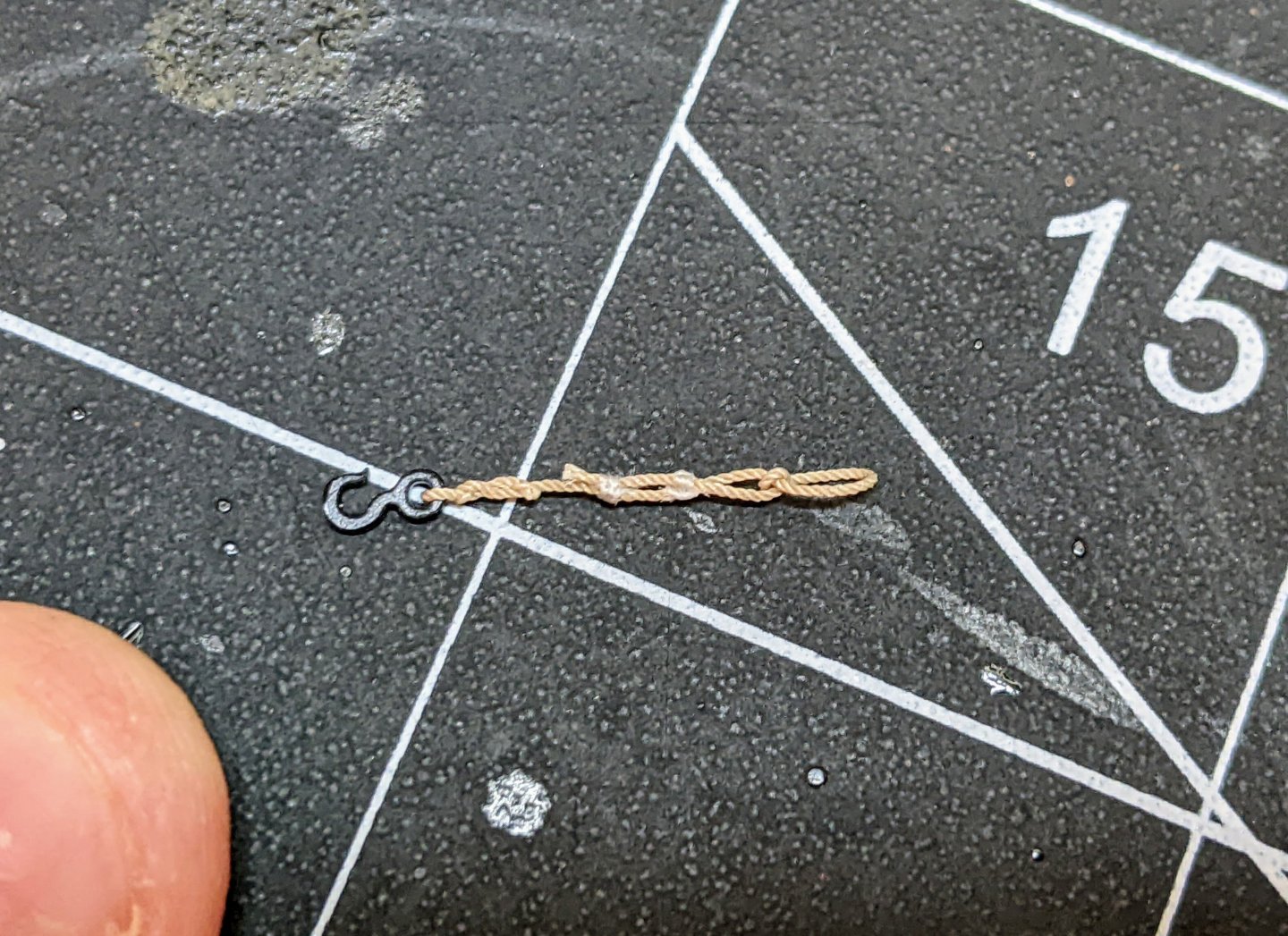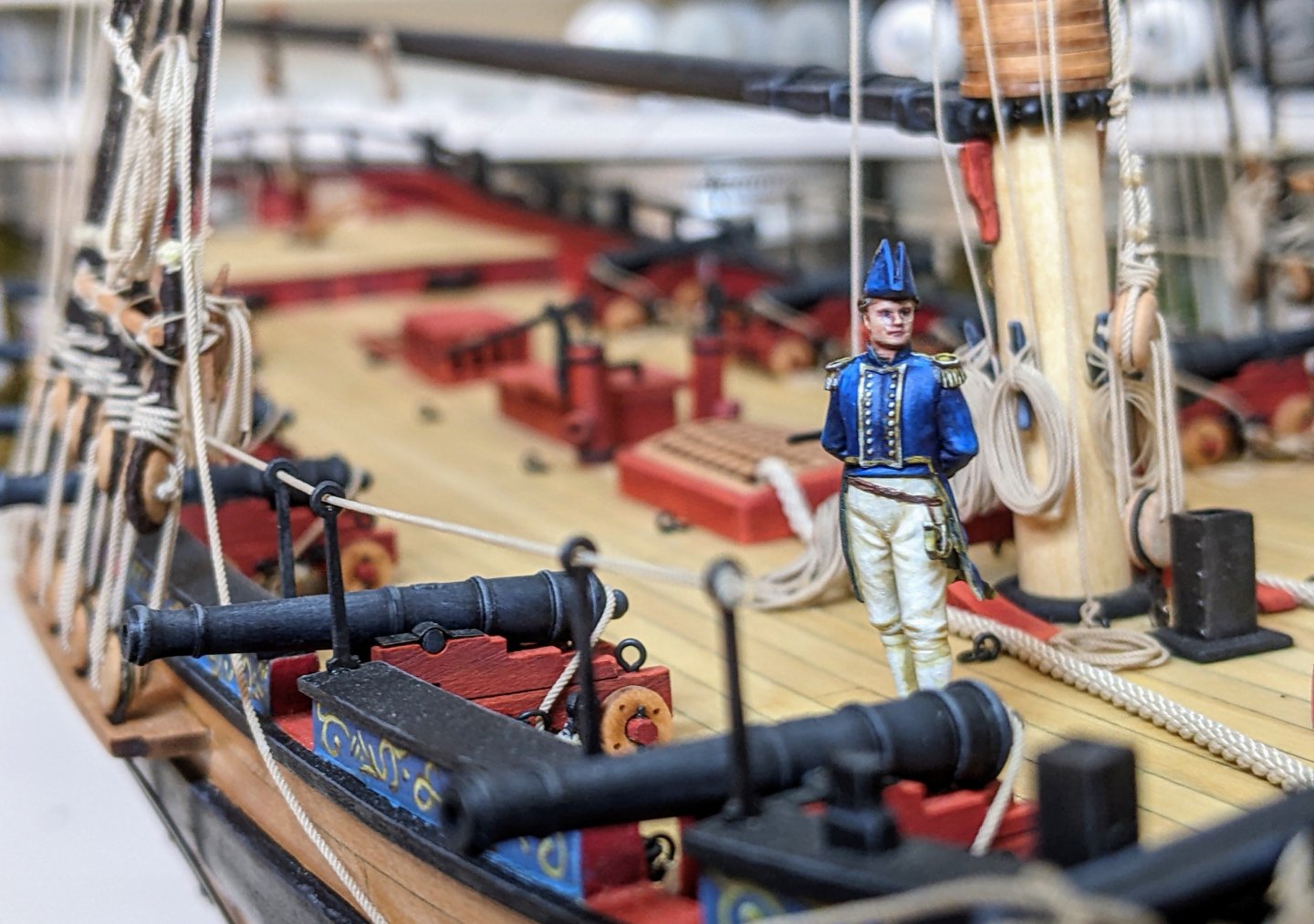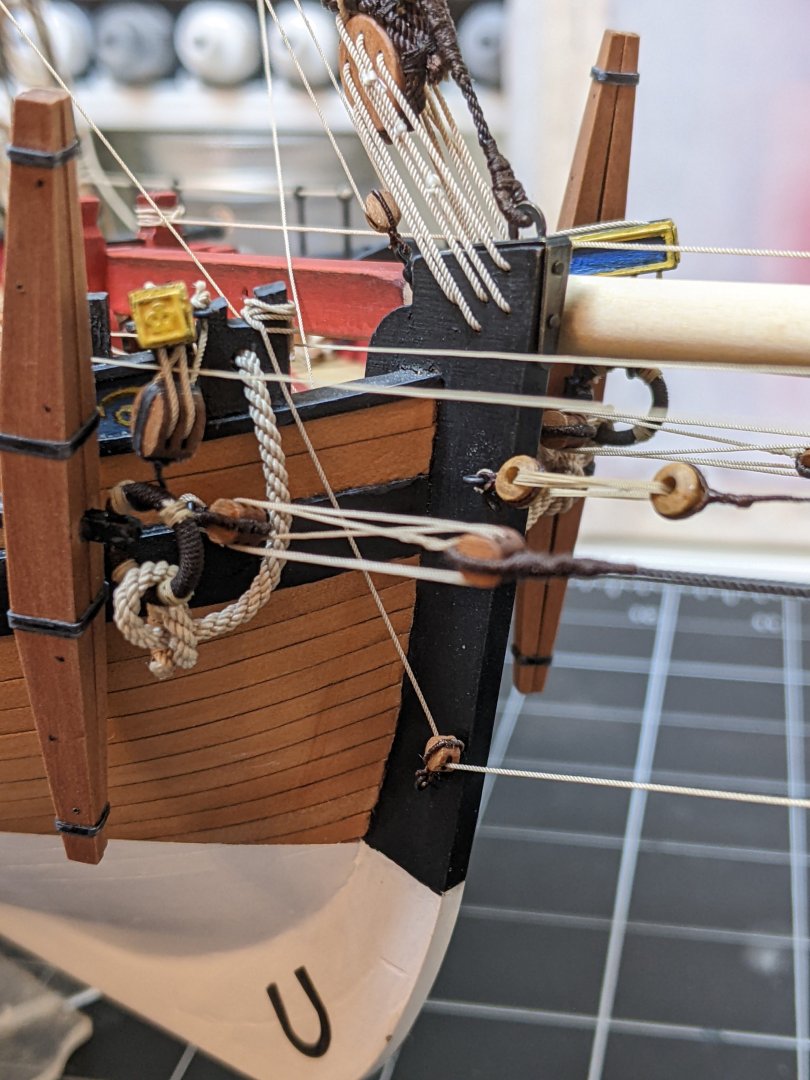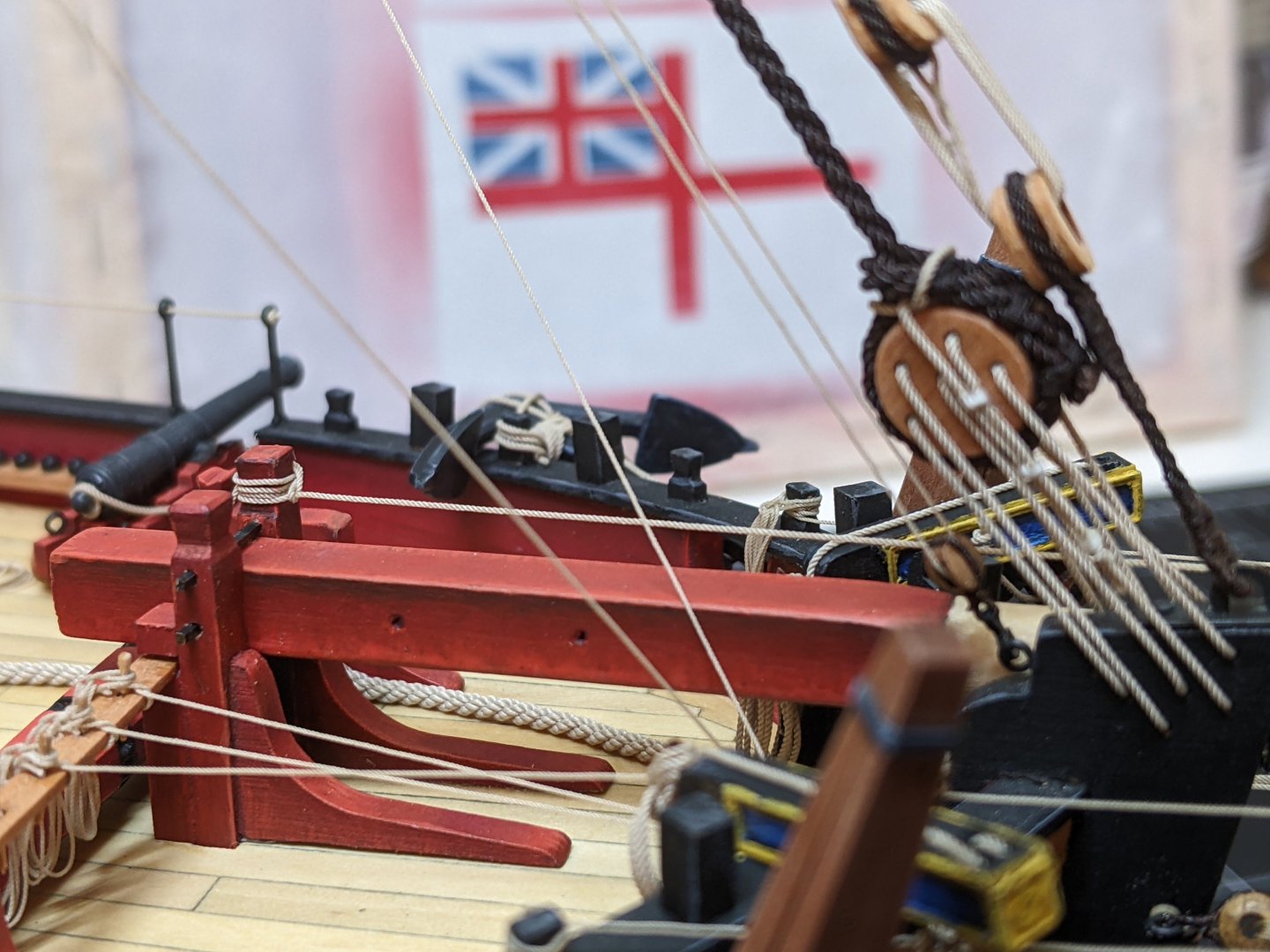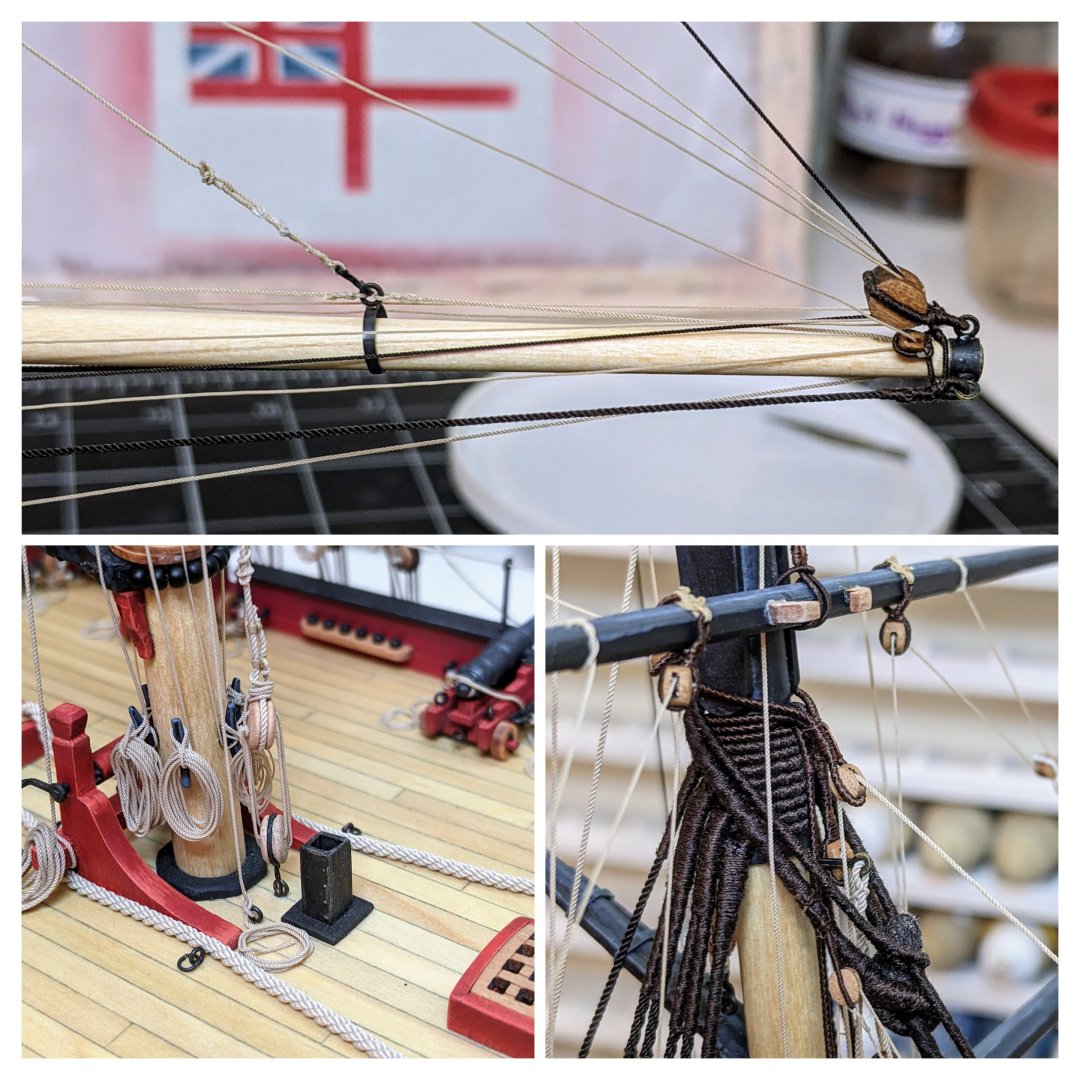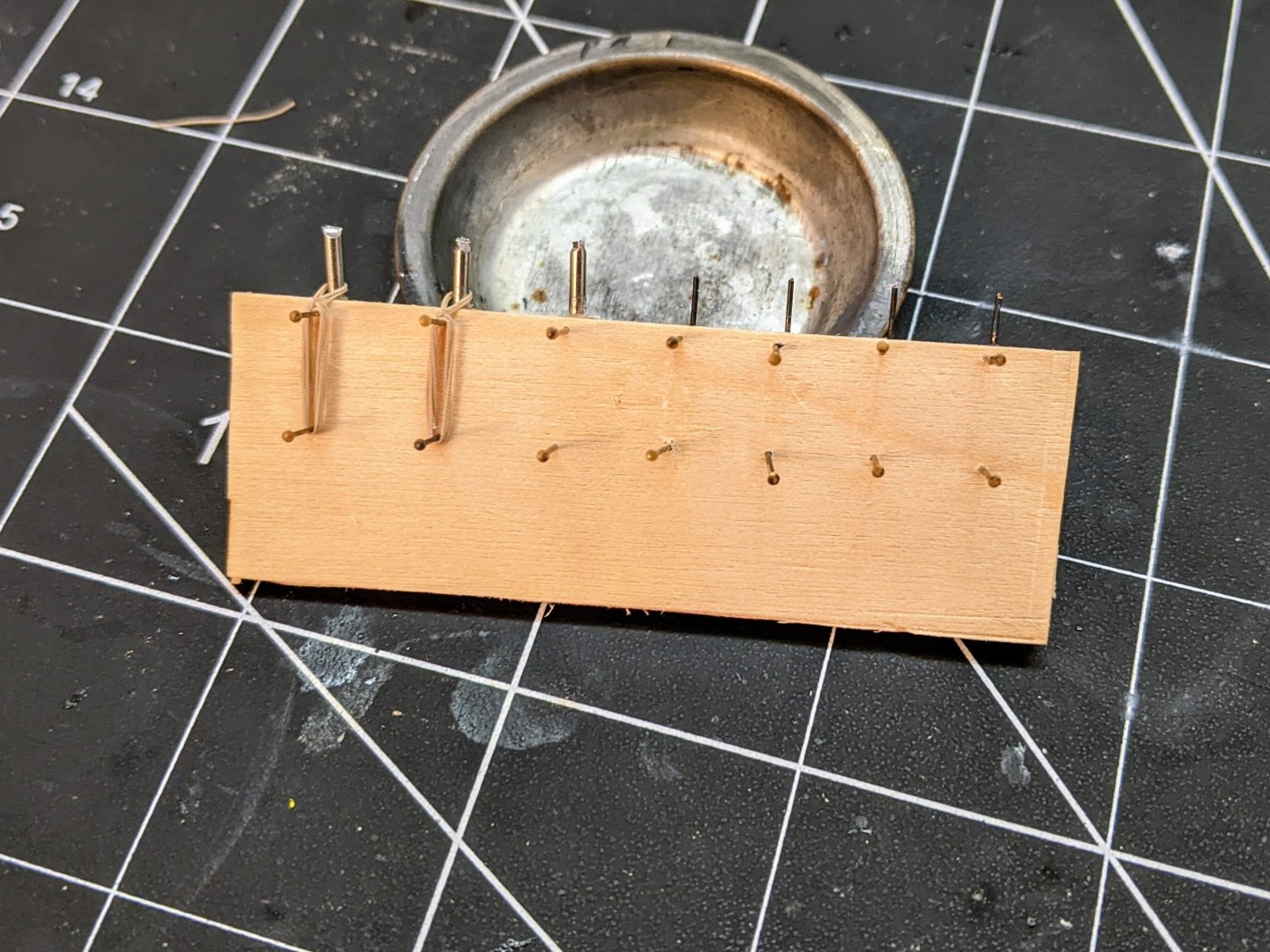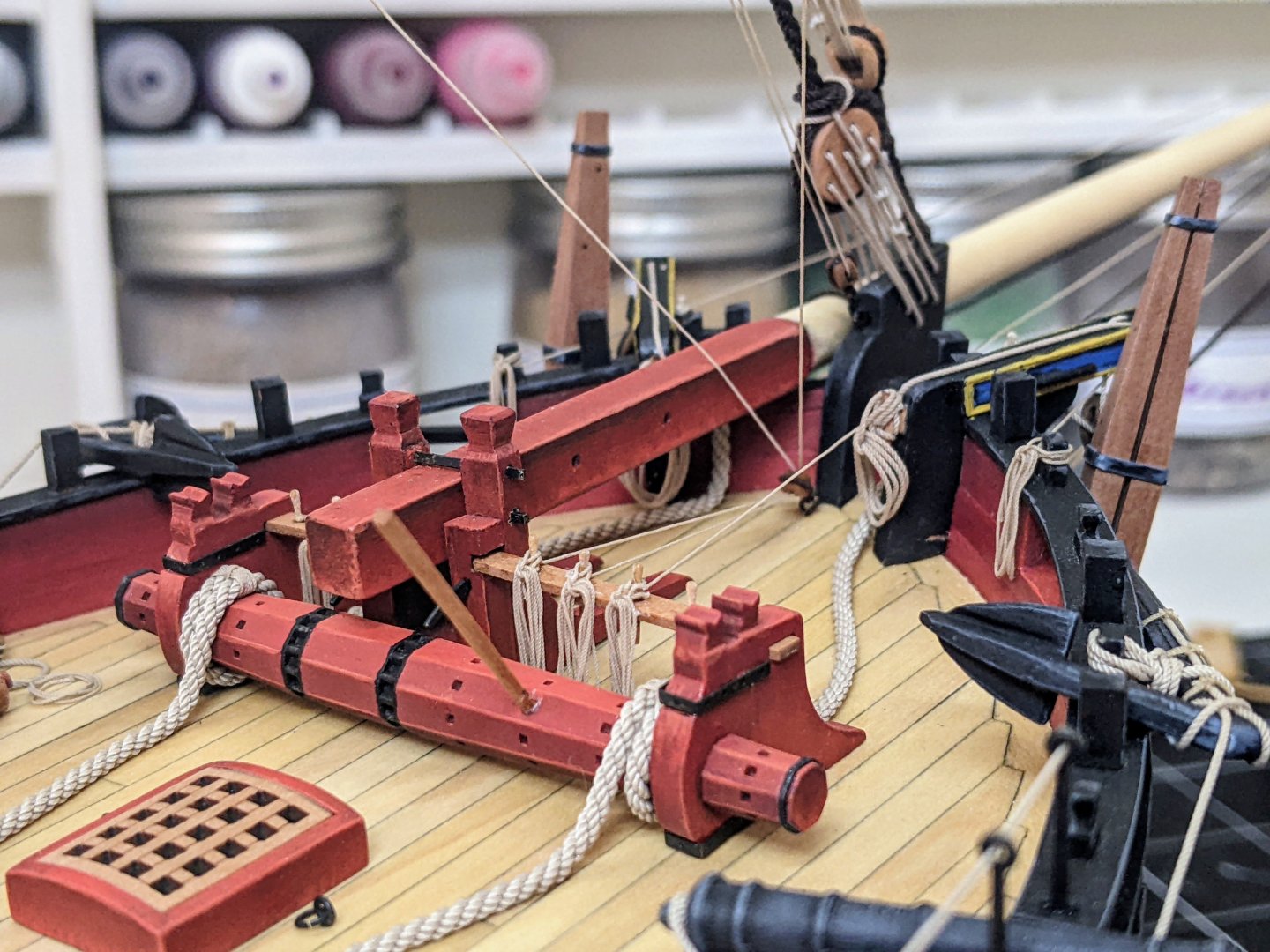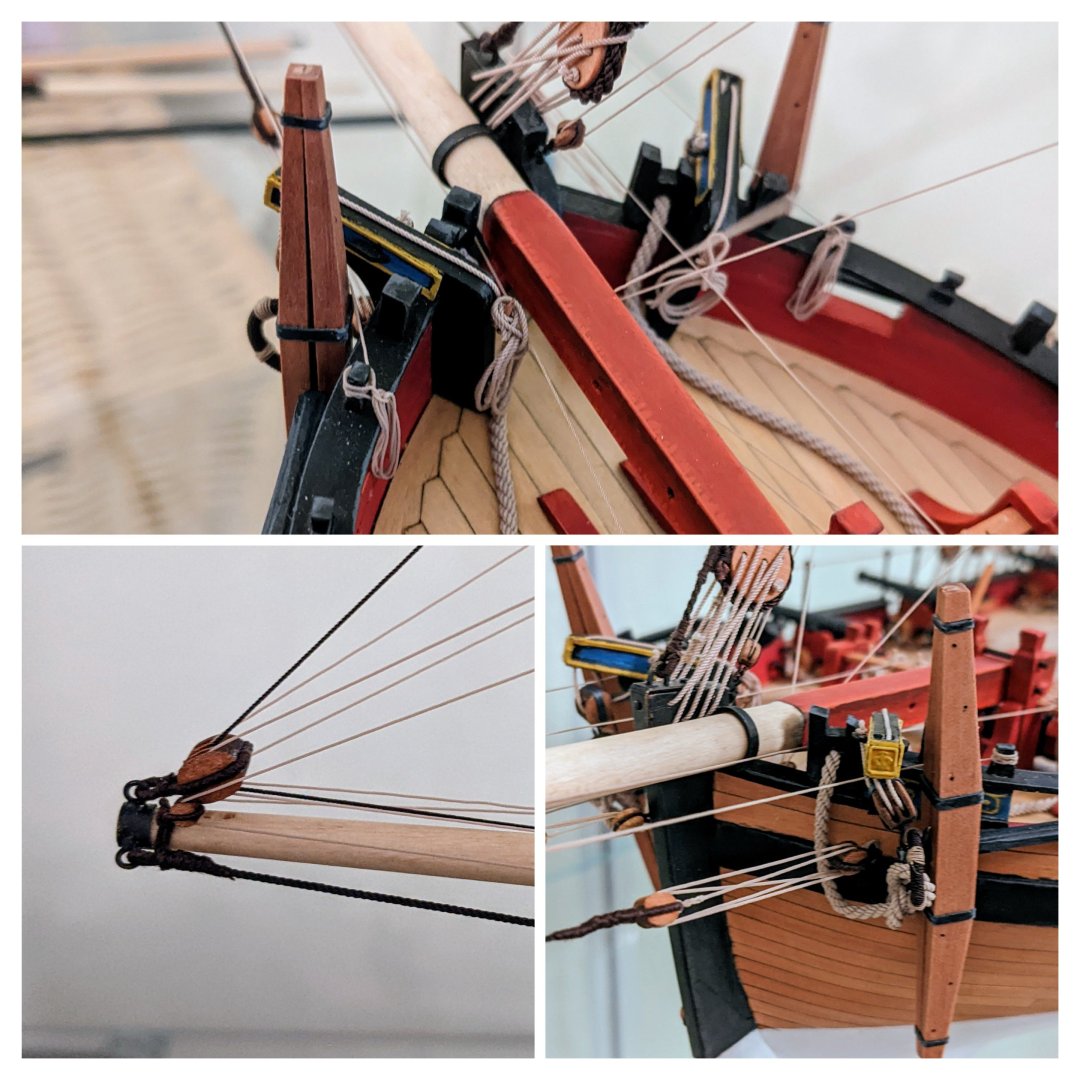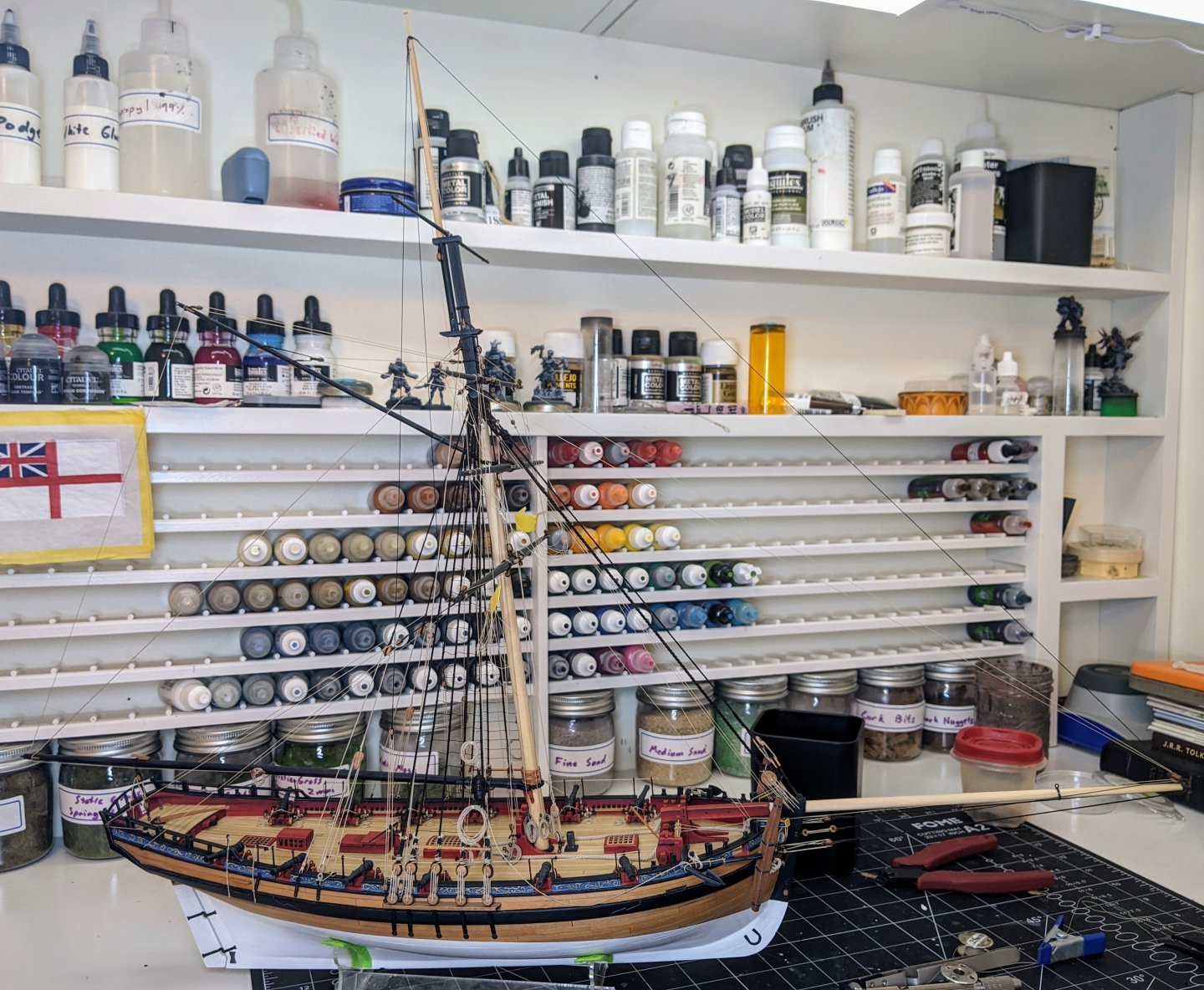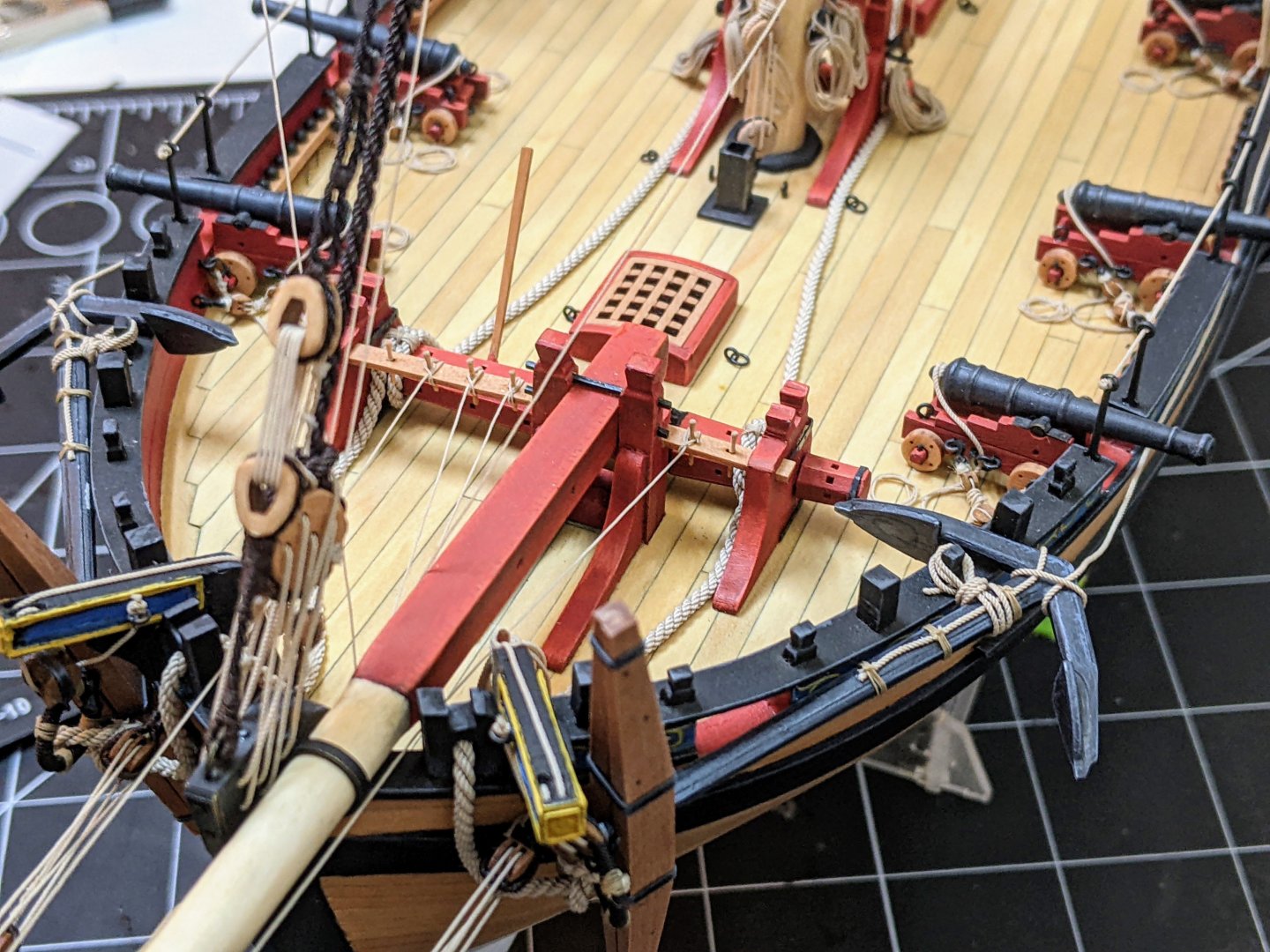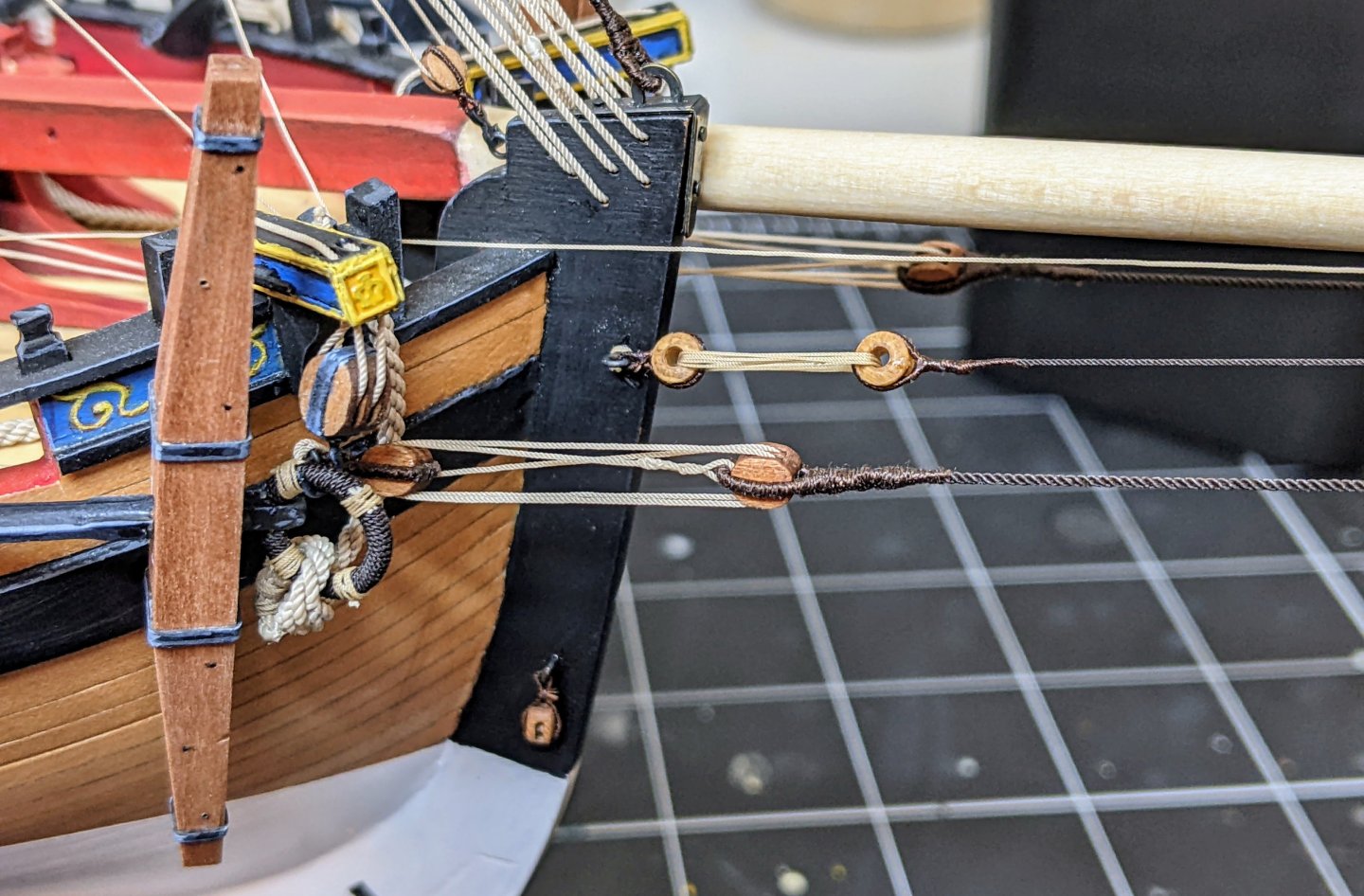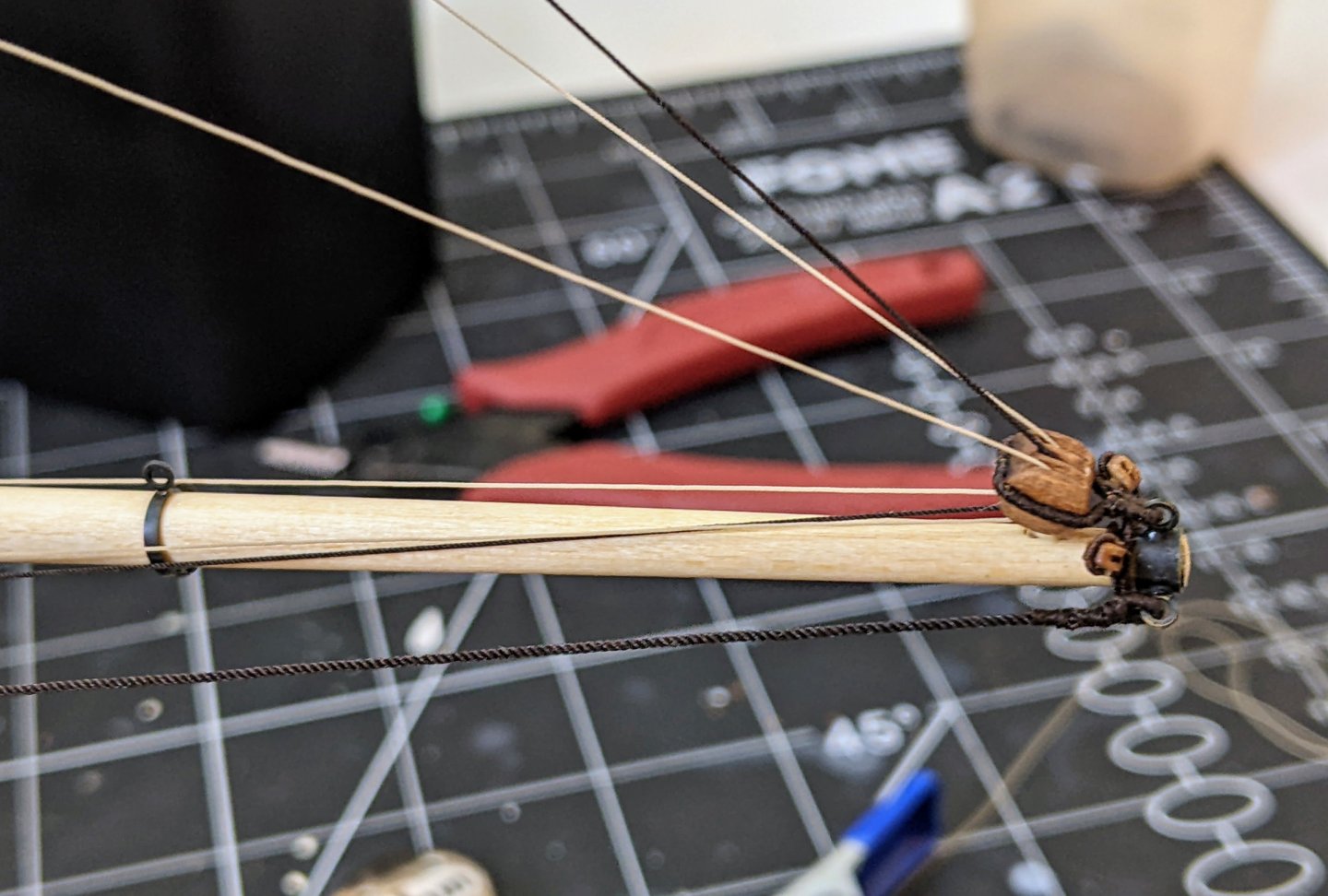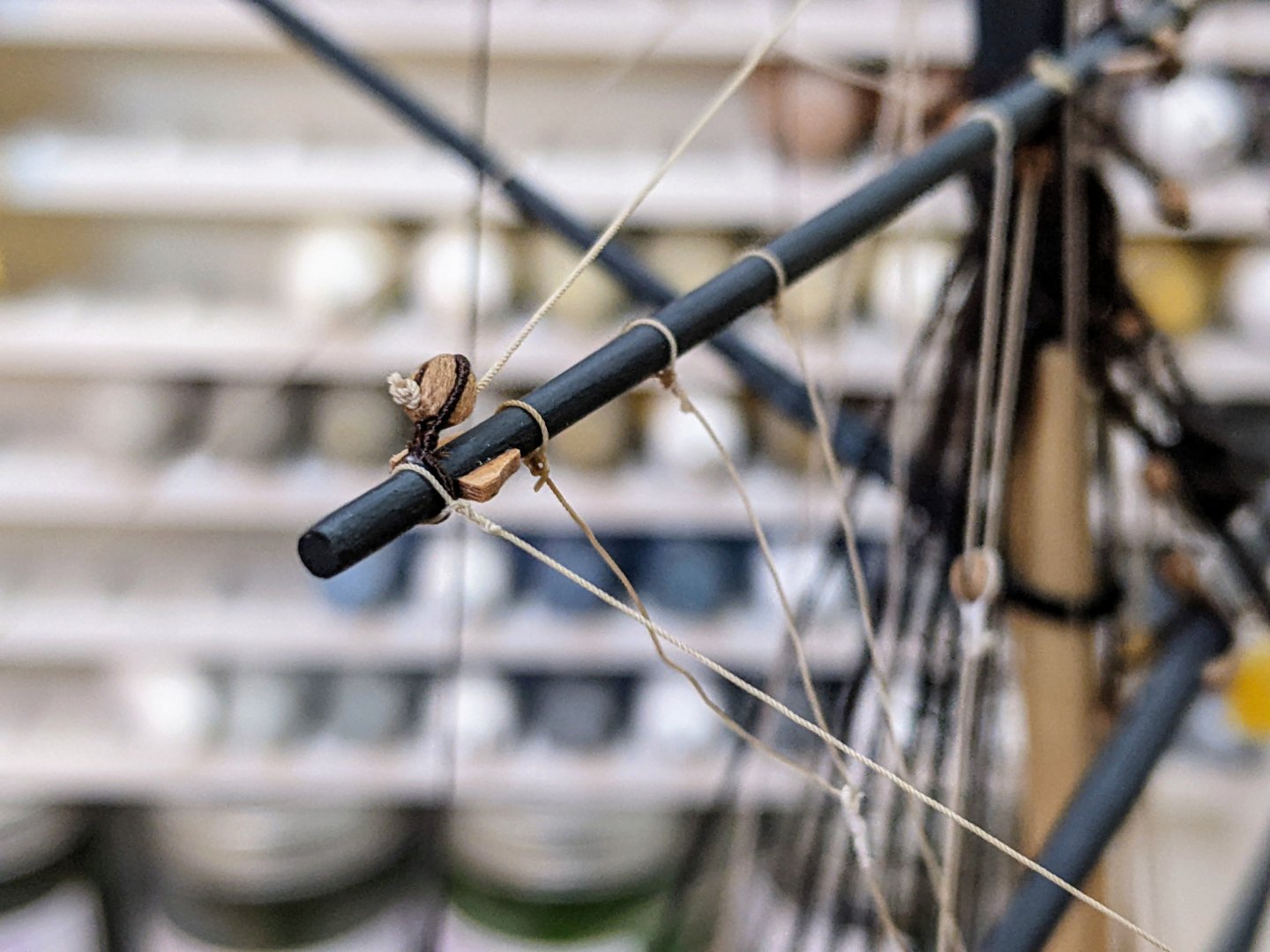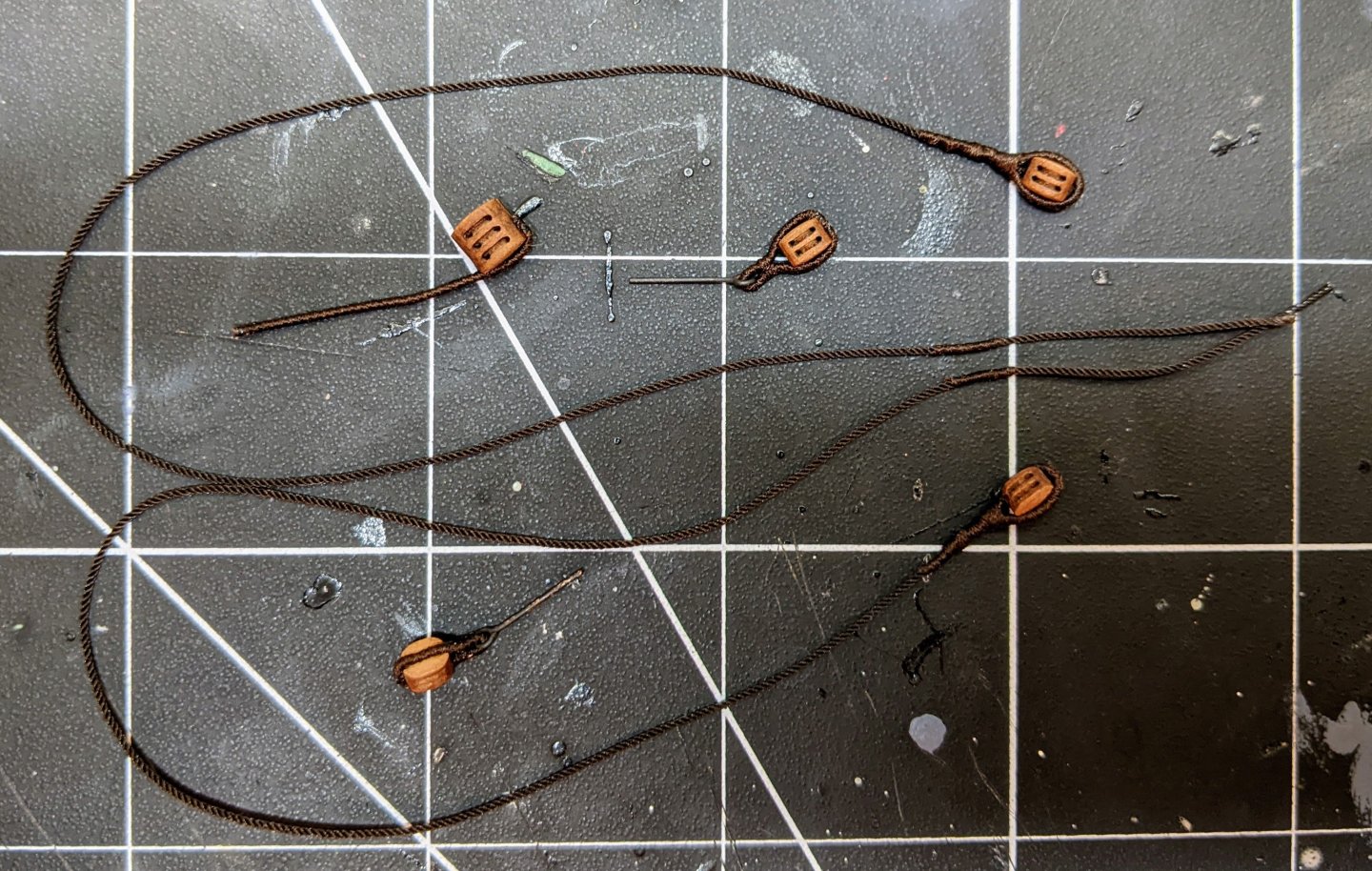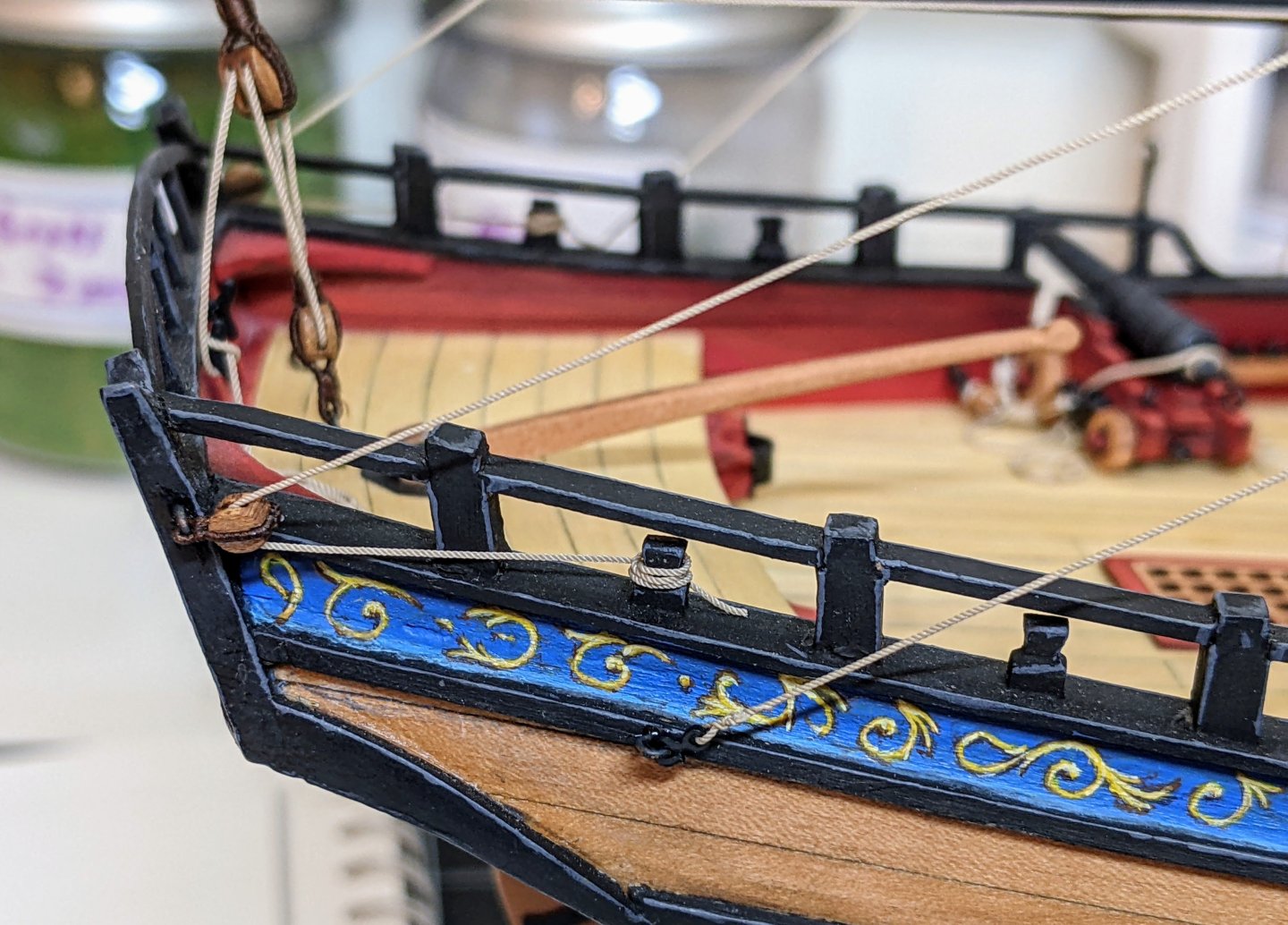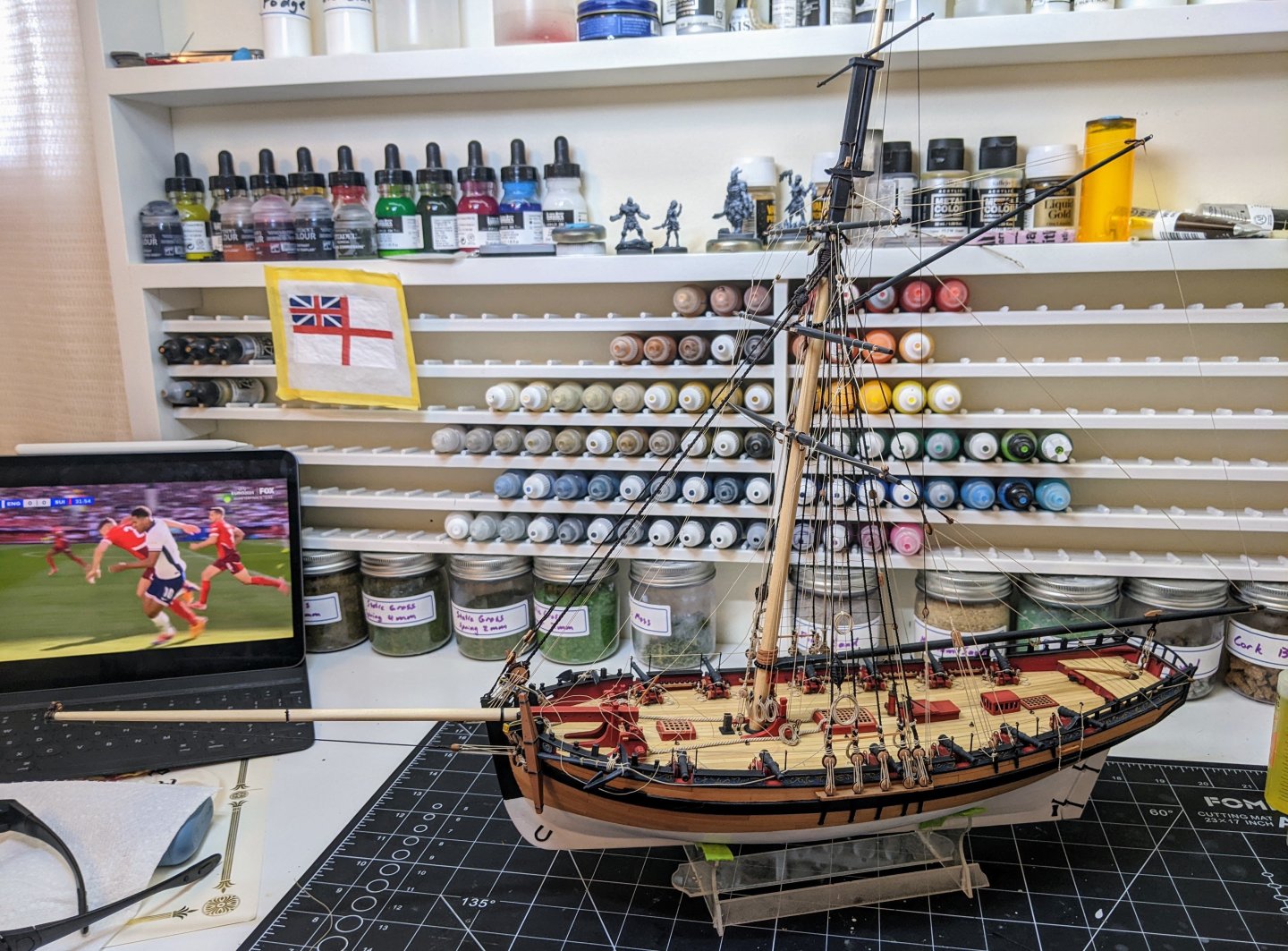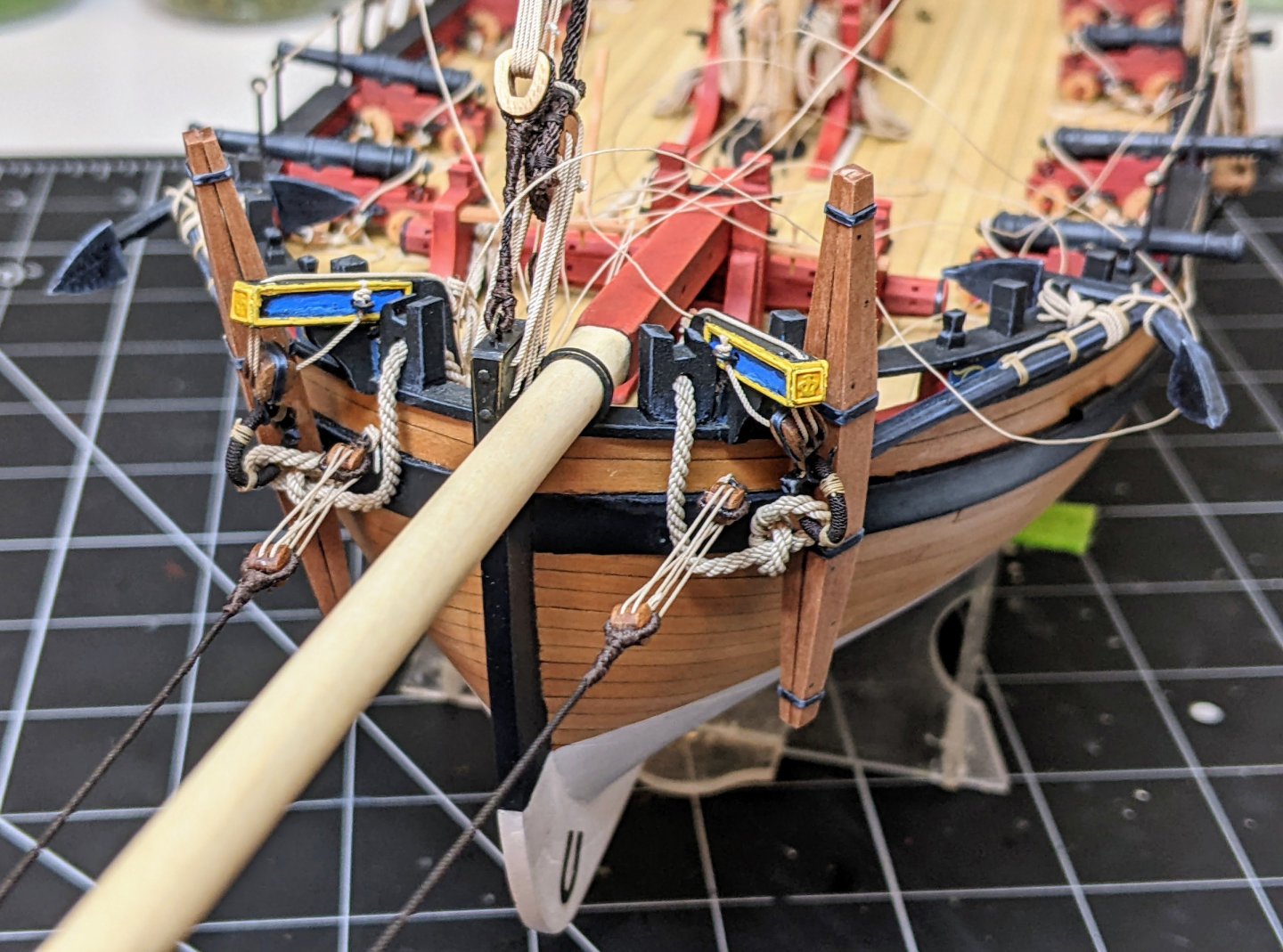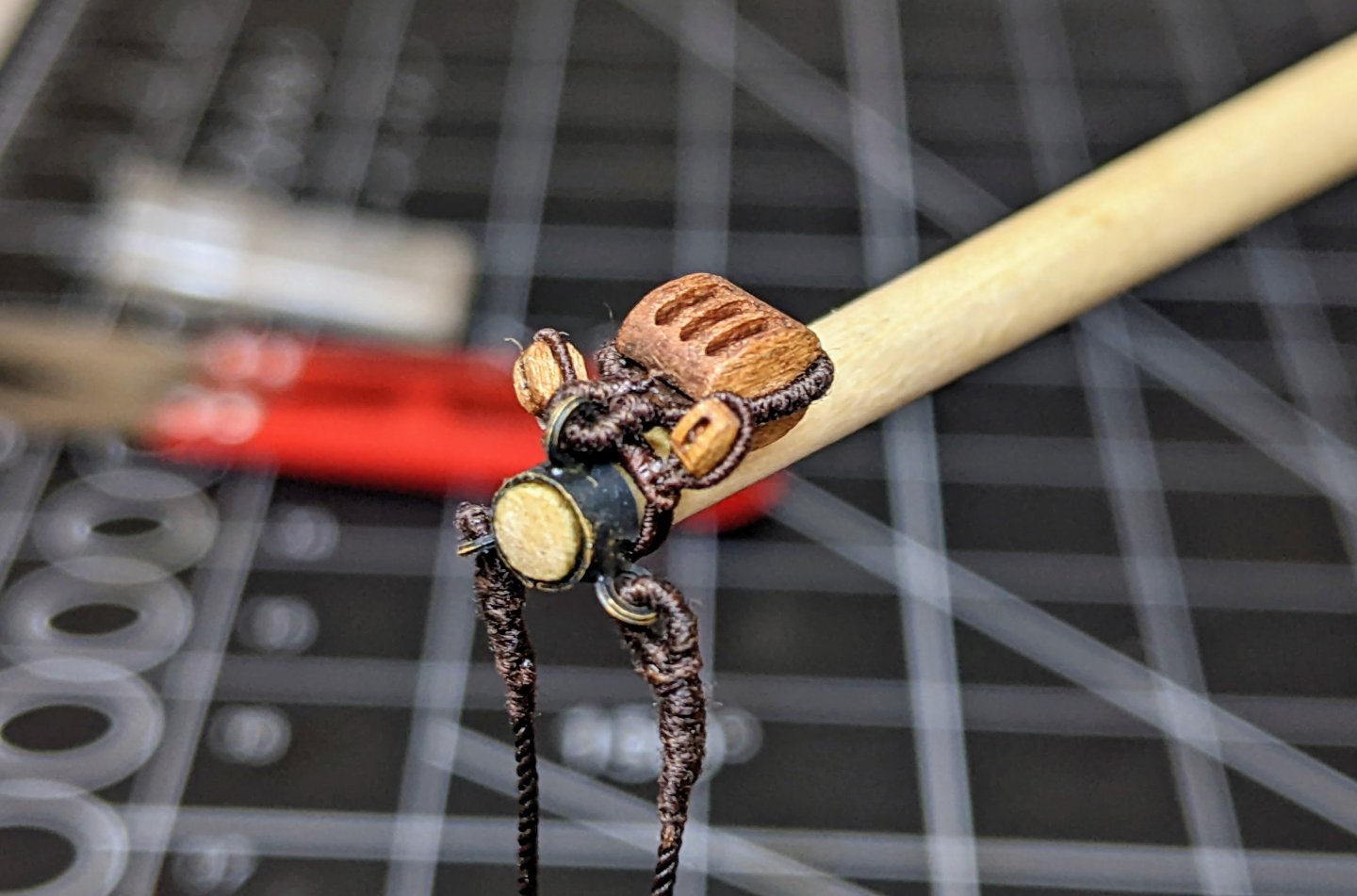-
Posts
1,345 -
Joined
-
Last visited
Content Type
Profiles
Forums
Gallery
Events
Everything posted by Thukydides
-
I am planning to do a smaller plastic model as a sort of interim project though I am not sure if I will do a build log for it. It will mostly involve painting which is harder to convey in a build log, we'll see. For my next wooden ship model I am well into the research phase, but I will talk about it a bit more once I am fully done with Alert.
- 562 replies
-
- vanguard models
- alert
-
(and 2 more)
Tagged with:
-
This is my main worry with the idea of signal flags (apart from the previously articulated historical issues). I like the thought of them in principal, but am worried it might clutter things up. I am thinking I may mock up a short (one number code) message on normal paper just to get a feel for what it looks like before deciding. I am planning on using the kit stand, the one you always see in my pictures is the original one, but I did purchase the newer version from Chris as well so that nicer one is what I will be using. I have a glass display cabinet it is going in (I will take a picture in it once everything is done, but the pictures don't turn out great due to the reflections). I actually keep Alert in this cabinet most of the time to protect her from dust and knocks between hobby sessions.
- 562 replies
-
- vanguard models
- alert
-
(and 2 more)
Tagged with:
-
Log #93: Rigging Complete The last remaining bit of rigging left is the jib. The inhauler, outhauler and halliard all round to the same thickness at our scale (0.35mm) so that is what I went with. The inhaler I tied off on the bits. The outhauler follows the kit arrangement and runs through a block on the stem. I was unsure of the best place to tie this off and in the end settled on just using the timber head like structure above the hawse hole. Neither of these needed significant extra rope so I didn’t do any coils. For the jib itself I followed the Goodwin arrangement by making the lanyard like attachment that hooks onto the ring and then runs through the jib cringe. It is a half hitch with the end served twice. The hook is spliced into the end of the rope. Then it was a simple matter of running the line for the jib. I used a double sheet knot fasten the end of the line to the lanyard with the hook on it. Then the line went up to the block on the masthead and then down to be tied off on an eyebolt. There were no free cleats left so I just left the rope coiled on the deck. With that I think the rigging is complete. There is not much further to go now. To celebrate this milestone I decided to finally place the commander on board. Any small things I have left will not require me to reach into the middle of the deck so he should be safe. Finally, I took a step back to catalog what remains to be done. In the background work on the swivel guns and ensign is ongoing and I am considering whether or not to add a pennant. Many contemporary drawings of cutters depict one, but I am undecided. I also am considering adding some signal flags. The issue here is Alert was captured by the French in 1778, but the only signal logs I can find online are for the system that came into effect in the early 1800s. Should I just use this or is it better not to bother with them. Any thoughts people have on either that or the pennants would be welcome.
- 562 replies
-
- vanguard models
- alert
-
(and 2 more)
Tagged with:
-

First timer introduction and needing some advice
Thukydides replied to Stuka's topic in New member Introductions
Sherbourne is a great kit. One masted ships are great for beginners. My first ship was Alert (also by Vanguard) and I love it. All you need in terms of tools really to get started is a craft knife and wood glue. I made my own pin pusher out of an old paintbrush. Hit up your local goodwill store to see if you can find a small iron, that will be best kind for plank bending. Apart from that your really don’t need much. better to wait till you really need a tool before spending money on it. Welcome to the forums -
If you want to paint metal parts you need to prime them first. Just normal acrylic paint won't stick. I suspect that is your issue with stuff rubbing off. Also a good rule of thumb is you can do oil over water but not water over oil. This is not completely true, but it is a good rule of thumb.
- 422 replies
-
- Vanguard Models
- Sphinx
-
(and 1 more)
Tagged with:
-
Log #92: More Rope Hanks While waiting for the rope I ordered to arrive I decided to finish off the lines I recently tied off and to tie off the topsail bowlines. The topsail bowlines are run through two small blocks tied to the end of the bowsprit, but at this point I ran into an issue. I had planned to run them to the pin rack on the windlass, but there is no way to get them there without tangling up in other lines. I suspect the problem is I needed to make the pendants longer so that the line would come in from higher up. However it is too late to fix that so I decided to run them to timberheads near the catheads. This is not a perfect solution, but I was able to run them under the catheads without impacting the ability to lower the anchor so I think it is fine. Following up on my previous hank jig, I made a new one to allow me to do a bunch of hanks at once. This lets me make multiple hanks at the same time and allows me to make two different sizes of loops for pins vs cleats. After tacking everything in place with super glue I blast them all with the hairdryer and then apply the diluted matt varnish as usual. A few hours later once dry I pull out the pins and remove the hank from the jig to be attached to the model. You can see below I have added 4 hanks to the pin rack for the squaresail bowlines and topsail braces as well as added two hanks to the timberheads where the topsail bowlines are tied off. Almost done with the rigging now. All that is left is the jib and then I need to do some checking to make sure I haven't missed any random lines or hanks.
- 562 replies
-
- vanguard models
- alert
-
(and 2 more)
Tagged with:
-
Great job on the claws. It is a relatively easy modification but I think it is one of those that really adds to the model.
-
Log #91: The Topgallant Stay & Topsail Braces Thank you again for all your kind comments and encouragement. I suspect that there are only a few more log entries to go as the list of things remaining to do is getting smaller and smaller. I once again underestimated how much rope I would need and ran out of the 0.35mm rope I need to do the jib so I decided to proceed with the topsail braces and topgallant stay. The topgallant stay was a little bit of trouble as I had already attached the block it will run through to the model and both ends of it need to be served. To get round this problem I first served the eye to slip over the top of the mast and then ran the rope through the block and stuck the other end in my serving machine. Since the rope is rather long there was enough slack that I was just able to get the serving done. Steel calls for 3in rope for the stay which is just slightly bigger than the 2.5in used for the topgallant backstays. However at scale this rounds to the same size of rope (0.35mm). This presented a problem, do I go with a slightly larger rope to illustrate the size difference or go with the more accurate rope size. In the end I decided to stick with 0.35mm rope. To attach the stay to the stem I used the kit arrangement as Goodwin is not clear how this is done. The lanyards were 0.2mm rope. The topsail braces steel give as 2in. This equates to 0.25mm at scale and I used BE’s arrangement just running them straight down to the bowsprit instead of the kit arrangement of the pendant with a block on it. And here you can see the tip of the bowsprit with the three lines running through the triple block. The block seemed a bit large and if I had any I would have preferred to use a 4mm one given the rope sizes running through it, but all I had was 5mm so it will have to do. At this point I tied off the squaresail bowlines to the pin rack on the windlass and also ran the topsail braces to this pin rack. I plan to add rope coils to all of these once I am done tying ropes off in this area. And finally here is a picture of her with all the new lines. She looks much more imposing with the braces and stay on her.
- 562 replies
-
- vanguard models
- alert
-
(and 2 more)
Tagged with:
-
The nails appear to be just in front of or just behind the frames. The most logical answer to me seems that you add some cross beams secured to the side of the frames right below where the nail patterns would be. This makes intuitive sense as the platform has to be secured to something and that something really should be secured to the frames. Great work as allways.
- 131 replies
-
- Medway Longboat
- Syren Ship Model Company
-
(and 1 more)
Tagged with:
-
Fantastic Glenn. She is quite the model.
- 587 replies
-
- Indefatigable
- Vanguard Models
-
(and 1 more)
Tagged with:
-
It is a fantastic painting and one of the few potential visual representations of the Sphinx ships. Do you plan to paint the lower counter black then? I did a bunch of digging but was never able to establish if Serres was actually present or if he worked off someone else's sketch or if he just made up the scene based on accounts of the action. During the seven years war many of his paintings were based on sketches from an eyewitness so given he was fairly old at this point I suspect it was one of the latter two options. At the very least he would have seen enough English ships to know what in general they looked like.
-
Thanks Ronald England has not been easy on the eyes this euro. I am sort of torn between cheering for them and wanting them to loose so I don't have to watch them anymore 🤣.
- 562 replies
-
- vanguard models
- alert
-
(and 2 more)
Tagged with:
-
Log #90: The Bowsprit Shrouds Thank you again to everyone who has liked and commented. The end is in sight now. Now that I have all of the ropes tied off at the base of the mast it was safe to finally finish off the spreadsail braces. You may remember that the pendants for these were done a long time ago when I first raised the yard and I delayed finishing them to preserve my access to the base of the mast. For this I used 0.35mm rope spliced to a hook on one end and tied off a timber head after being run through a 3mm block at the other. I also decided this was the time to rig the foresail halyard. I gave this a fair bit of consideration as how to do this is not entirely clear from the Goodwin book, but in the end I decided to copy the arrangement used by BE. I used 0.25mm line run through a 3mm block hooked on to the stem and then through a 3mm block on a pendant which is seized to the mainstay. The line was then run down to a cleat on at the base of the mast. With that done, it was time to start work on the bowsprit. According to Steel the bowsprit shrouds are 5.5in diameter with 10in double blocks. Goodwin doesn’t show this part in detail and the kit uses single 3mm blocks which are a bit on the small size for the 0.6mm rope I used. So I decided to go with 4mm double blocks. At this time I also prepared the triple block for the end of the bowsprit. The serving of the eyes of the shrouds was a bit tricky as this had to be done on model, so what I did was serve a section as can be seen above. Then I spliced the ends together on the model and then sized over the splice manually. For the tackles of the shrouds I used 0.35mm rope and tied it off to the base of the eyebolt attaching the blocks to the hull. And here is what everything looks like at the moment. Things are a bit of a mess as I am waiting till most of the other lines are in place before I tie off the bowlines.
- 562 replies
-
- vanguard models
- alert
-
(and 2 more)
Tagged with:
-
Welcome to MSW
About us
Modelshipworld - Advancing Ship Modeling through Research
SSL Secured
Your security is important for us so this Website is SSL-Secured
NRG Mailing Address
Nautical Research Guild
237 South Lincoln Street
Westmont IL, 60559-1917
Model Ship World ® and the MSW logo are Registered Trademarks, and belong to the Nautical Research Guild (United States Patent and Trademark Office: No. 6,929,264 & No. 6,929,274, registered Dec. 20, 2022)
Helpful Links
About the NRG
If you enjoy building ship models that are historically accurate as well as beautiful, then The Nautical Research Guild (NRG) is just right for you.
The Guild is a non-profit educational organization whose mission is to “Advance Ship Modeling Through Research”. We provide support to our members in their efforts to raise the quality of their model ships.
The Nautical Research Guild has published our world-renowned quarterly magazine, The Nautical Research Journal, since 1955. The pages of the Journal are full of articles by accomplished ship modelers who show you how they create those exquisite details on their models, and by maritime historians who show you the correct details to build. The Journal is available in both print and digital editions. Go to the NRG web site (www.thenrg.org) to download a complimentary digital copy of the Journal. The NRG also publishes plan sets, books and compilations of back issues of the Journal and the former Ships in Scale and Model Ship Builder magazines.

